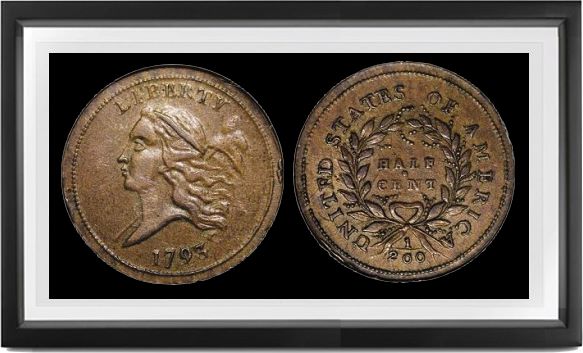Park Avenue Numismatics
5084 Biscayne Blvd, Suite 105
Miami, FL 33137
Toll Free: 888-419-7136
Secure Private Ordering
We use the latest online security processing,
so your order is safe & private.
We DO NOT disclose any customer
information to ANY third party company.
Our customer privacy is our priority.
Over 30 Years Experience
Park Avenue has over 30 years
experience buying and selling
Rare Coin and Precious Metals.
We have the knowledge and
ability to provide our customers
with the best products and services.




THE HALF CENTS OF 1793

IN MANY WAYS the first type coin of the regular United States series, the 1793 half cent, is—as a design—unique. It is the first American coin ever to depict a Liberty cap, antedating the cents by four months. It is the only one known to have been designed and at least partly engraved by Adam Eckfeldt. It is the only one to have the head with cap and pole turned to left, in this was explicity acknowledging the design’s ultimate prototype in Augustin Dupre’s LIBERTAS AMERICANA medal (Betts 615, Lou-bat 4, AJN XXIII, 33), engraved in 1782, but familiar because some silver specimens had been presented to members of Congress in the ensuing years. It is the smallest and thickest of the half cents, and the only half cent prior to 1831 to have borders consisting entirely of round beads. It is the only half cent to have two leaves following DOLLAR on edge, a feature which connects it in time with the wreath cent Sheldon 11b.
There are two obverse and three reverse dies; the obverses match in style the obverse of the 1792 Disme. (Pronounce it deem to rhyme with steam, if you want it to sound as it did when it was made; the pronunciation dizz-mee is completely wrong and without basis. Deem was replaced by the modern pronunciation dime well before 1837 when the S was dropped.) Attribution to Adam-Eckfeldt rests on the best possible authority: Eckfeldt’s own word. On November 4, 1801, Eckfeldt testified under oath that before becoming Assistant Coiner at the beginning of 1796, he had been working “in the Engraver’s Department.” In W. Elliot Woodward’s catalogue of the Jeremiah Colburn collection, October 20-24, 1863, lot 2021 was a broad-flan Uncirculated 1793 half-cent which Eckfeldt himself had presented to the owner as “a sample of his work.” Edgar H. Adams (Numismatist, February 1911) quoted an early claim that Eckfeldt had “made” the dies.
Reverse dies have been attributed to Robert Birch on the basis of resemblance between them and the reverses of the 1793 Wreath cents and the large 1792 Wreath cent whose obverse is signed BIRCH, much the same kind of laurel (?) leaves being used on all, with similar sprays of berries unlike olive or laurel.
The 35,334 half cents of this year were made between July 20 and September 18, 1793. Copper blanks used for making them were cut down from strip rolled from ingots made in the Mint from a variety of scrap copper. Quite a number of Uncirculated specimens survive of this date, evidently saved as souvenirs even aside from the few given out to friends by Adam Eckfeldt, Director David Rittenhouse, or other officials; there are also still more in AU or thereabouts. A fair estimate for the four varieties together: over twenty full Mint State coins, possibly five or six of them showing part original red, and at least twenty more in AU. However, the vast majority of survivors are in well worn condition. The four varieties—three R-4’s and an R-5, Sheldon scale—together have a total population of less than 525, which is a little over 1½% of the original mintage. The average “Characteristic Ratio” (number surviving/number minted) for half cents of all the years 1793-1811 is in the neighborhood of 1% where it can be ascertained at all—compared with 1% for early gold, 3% for early cents, and 4% for at least some series of early silver; “characteristic” of each denomination and type, hence the name. The ratio is higher for 1793 than for 1794 or later years because of the number saved as souvenirs, always larger for first year of issue than for later years in all series except half dollars. Think on the implications of a 1% C.R. for a moment: It means that of every 100 pieces minted, 99 have long since perished. We collectors are curators of a vanishing remnant of history.











